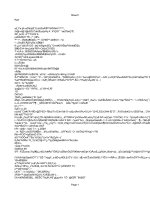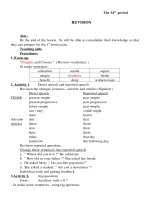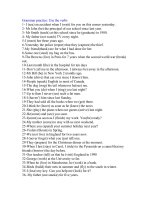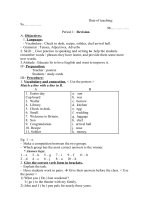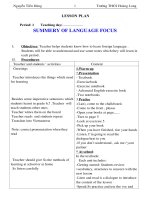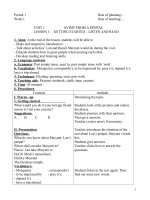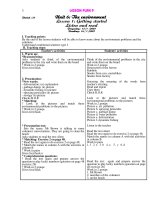Giáo án tiếng anh 9 HKI
Bạn đang xem bản rút gọn của tài liệu. Xem và tải ngay bản đầy đủ của tài liệu tại đây (251.46 KB, 52 trang )
Teaching plan – English 9
Unit 1: a visit from a penpal.
I. Aims
Helping students :
- Make and repond to intrductions
- Scan for specific informations
- Write a respond letter.
II. Language focus.
1- The past simple.
2- The past simple with “ wish”
lesson 1
Period : 2 Getting started & Listen and read
Language focus 3
Date of teaching: 21/08/ 2008
I- Objectives: Reading the text for details
- By the end of the lesson, Ss will ge able to know about some places Lan went to with a
foreign friends and some activities they took part in together.
II- Language content
-Vocabulary:
- Grammar or structures: WISH mong íc ë hiÖn t¹i
III- Teaching aids
- Pictures, text book and cassette and cassette-player
IV- Procedures
Procedure
Stages Contents
Activities
Warm up
Presentation
Getting started:
- Ask students to tell some places of interest in
Thanh hoa.( Sam Son Beach, Cam Luong Deity fish
stream, Tu Thuc Cave, Ben En National Park, Lam
Kinh Historical Vestiges…)
- Ask Ss to work with their partners:
A foreign pen pal is coming to stay with you for a
week. What activities would you do during the visit?
Listen and read
* Pre- teach vocabulary.
- pen pal (n) – atmosphere (n)
- correspond (v) – pray (v)
Pair work
Individual work
NguyÔn V¨n Khoa –Lª H÷u LËp Lower secondary school
School year: 2008 - 2009
1
Teaching plan – English 9
Practice
Production
Home work
- impress (v) – wish (v)
- friendliness (n) – depend on (v)
- mausoleum (n) – recreation (n)
- Mosque (n)
- To get to know.
- To keep in touch with.
* Checking vocabulary: Rub out and remember.
* New structures:
The past simple with “WISH“ (mong íc ë hiÖn t¹i)
S+ wish(es) + S + V (past subjuntives:
tobe:were)
Ex: I wish I had a car.
Nam wishes he were taller.
* Open - prediction.
Lan’ Malaysian penpal came to visit her last week.
Can you guess where she went and what she did
during her stay?
- Read the text, ask Ss to listen and check their
prediction.
- Ask Ss to read the text again to choose the correct
option to complete the sentences on page 7
- Give answer key.
1- C 2- B 3- D 4- B
- Ask Ss to recommend places of interest in their
city/ province.
- Ask them to discuss where they should take their
friends to and what activities they should do.
Language focus 3
- Ask Ss to read the situations in text book and made
sentences with Wish.
- Give feedback and give correct the answer
- Have Ss write a short pharagraph about what they
have just discussed with their partner.
- Whole class
- Individual
work
- Individual
- Individual/
Group work.
- individual work
- group work
- individual work
V- adjustments
……………………………………………………………………………………
NguyÔn V¨n Khoa –Lª H÷u LËp Lower secondary school
School year: 2008 - 2009
2
Teaching plan – English 9
……………………………………………………………………………………
……………………………………………………………………………………
……………………………………………………………………………………
……………………………………………………………………………………
-------------------------------------------------------------------
Unit 1: a visit from a penpal
Date of teaching: 21/08/2008
lesson 2 : speak Period : 3
I- Objectives: - Make and respond to introductions.
By the end of the lesson Ss will be able to make and respond to introductions.
II- Language content:
III- Teaching aids
- Pictures, text book ,cards
IV- Procedures
Procedure
Stages Contents
Activities
Pre-
speaking
While-
speaking
* Palmanism:
- prepare 10 cards with number on side and the countries
and their cities on the other: Tokyo – Perth –
Liverpool – Bombay – Hoi An – Japan Australia –
England – India – Viet Nam.
- Make sure the countries and the cities are mix up. Stick
the cards on the board so Ss can only see the numbers.
- Divide the class in to 2 teams and ask them to choose 2
numbers.
- Turn over the cards and see if they match. If not, turn
the cards face down again and ask the other team to
choose.
- Continue until all the cards are turned over.
- Introduce the situation: Nga is talking to Maryam.
They are waiting for Lan outside her school.
- Ask Ss to work in pairs to put the sentences in the
correct order to make a completed dialouge.
* Anwer :
1 – c – 5 – b – 4 – d – 2 – e – 3 – a
- Group work
Team work
Pair work
NguyÔn V¨n Khoa –Lª H÷u LËp Lower secondary school
School year: 2008 - 2009
3
Teaching plan – English 9
Post-
speaking
Home
-work
- Ask Ss to practice speaking the dialouge
( reverse roles )
* Set the scene: Now you are talking to Maryam’s
friends. Introduce yourself.
- Make the similar dialogues. Take turns to
be Maryam’s friends.
Ex:
A. Hello, You must be Joko.
B. That’s right, Iam.
A. Please to meet you. Let me introduce myself. I’m
Nam.
B. Please to meet you , too,Nam.
A. Are you enjoying your stay here ?
B. Oh, yes ,very much. I like VietNamese people and I
love old cities in VietNam.
A. Do you live in the city, too ?
B. Yes, I live in Tokyo. Have you been there ?
A. No, What’s it like ?
B. It’s a busy big capital city
A. I see.
- Ask some pairs to present their dialouges in the class.
- Then ask Ss to practice with their partner.
- Ask Ss to make up a similar dialouge at home and
prepare the new lesson.
Pair work
- Pairs work
V- Adjustment:
……………………………………………………………………………………….
……………………………………………………………………………………….
……………………………………………………………………………………….
……………………………………………………………………………………….
……………………………………………………………………………………….
……………………………………………………………………………………….
---------------------------------------------------------------------------
Unit 1: a visit from a penpal
lesson 3 :
Period : 4 Listen - Language focus 1,2
NguyÔn V¨n Khoa –Lª H÷u LËp Lower secondary school
School year: 2008 - 2009
4
Teaching plan – English 9
Date of teaching:28/08/2008
I- Objectives: By the end of the lesson Ss will be able to listen to specific information to
select the correct pictures and do exercises 1,2 in Language focus.
II- Language content: past simple tense (review)
III- Teaching aids
- Pictures, text book and cassette
IV- Procedures
Procedure
Stages Contents
,
Activities
Warm up
Pre-
listening
While-
listening
Post-
* Jumbled words:
+ rkap = park
+ rssag = grass
+ tccah = catch
+ ondp = pond.
- Divide the class in to 2 teams.
- Ask Ss from each team to go to the board to write
down the correct words.
- The team which is faster with more correct words wins
the game.
Set the scene: Tim Jones’s mexican penpal,Carlos, is
visiting the USA .
- Ask Ss to look at the pictures and tell the class what
there is in each one, where the place is, what the people
are doing.
-Vocab: sign(n) , park keeper (n), hamburgers(n)
* Open predictions:
- Tell Ss Tim is taking Carlos to some places. Ask them
to think of three things that Tim and Carlos are doing.
- Possible answers:
+ They‘re going to the park.
+ They are taking a bus.
+ They are going to a restaurant.
- Ask Ss to listen to the tape to check their guesses.
- Give the feedback.
- Ask Ss to listen to the tape the second time to choose
the correct picture.
- Answer key: a) picture 1 b) picture 2 c) picture 2
* Language focus.
1- Ask Ss to read the sample dialouge.
- Team work
- Individual.
- Individual
work
NguyÔn V¨n Khoa –Lª H÷u LËp Lower secondary school
School year: 2008 - 2009
5
Teaching plan – English 9
listening
Home
work
- Ask them to work in pairs to ask and answer about
what Ba, Nga, Lan, Nam and Hoa did on the weekend.
- Have some pairs present their dialouge before class.
- Correct mistakes if neccesary.
2- Introduce the situation.
- Have Ss look at the pictures and read the given words.
- Ask them to use the given words and the pictures to
write complete sentences.
- Ask them to read their sentences aloud.
- Correct mistakes if neccesary.
- Give feedback:
Nga made a cake.
Nam hung colorful lamps.
Hoa bought some flowers.
Ba painted a picture of Ha Noi.
Lan and Huong went shopping.
- Ask Ss to do at home agai
- Pair work
Individual work
Unit 1: a visit from a penpal
lesson 4 :
Period : 5 read
Date of teaching:28/08/2008
I- Aim: Reading the text for details
II- Objectives: By the end of the lesson Ss will have some knowledge about Malaysia, one
of the countries of ASEAN
III- Teaching aids
- Pictures, text book and map of countries of the ASEAN.
IV- Procedures
Procedure
Stages Contents
Activities
NguyÔn V¨n Khoa –Lª H÷u LËp Lower secondary school
School year: 2008 - 2009
6
Teaching plan – English 9
Warm up
Pre
reading
While
reading
Post-
reading
* Hangman.
- the word has - - - - - - - - letters.
=> It’s Malaysia.
* Ask Ss some questions about Malaysia .
+ Where is Malaysia ?
+ What is the capital of Malaysia ?
+ What language is spoken in there ?
+ What is its population ?
+ How big is Malysia ?
- Teach vocabulary.
Devide (v) separate (v)
Region (n) comprise (v)
Tropical (a) official (a)
Climate (n) Tamil (n)
Population (n) compulsory (a)
Currency (n) Islam (n)
Religion (n) Hinduism (n)
- Ask Ss to read all the new words and explaining their
meaning.
* Ask Ss to read the text to fill in the table.
1- Area: ……………………………………….
2- Population: …………………………………
3- Climate: ……………………………………
4- Unit of currency: …………………………..
5- Capital city: ………………………………..
6- Offical religion: ……………………………
7- Nation language: …………………………..
8- Compulsory language: …………………….
*Ask Ss to read the text to do the true/ false
statements.
- Give feedback.
1-T
2-F (There are more than two religions.)
3- F (English,Chinese and Tamil are also widely
spoken.)
4- F (One of the three: Malay, Chinese, Tamil)
5- F (English is a compulsory second language, not
primary language of instruction.)
* Ask Ss to answer the following questions:
1. What is the area of Malaysia?
Whole class
Individual
Pairswork
T – whole
class
Whole class
Individual work
-Individual
work
-individual
work
NguyÔn V¨n Khoa –Lª H÷u LËp Lower secondary school
School year: 2008 - 2009
7
Teaching plan – English 9
Home
work
2. What is the population of Malaysia?
3. What is the unit of currency of Malaysia?
4. What is the official religion of Malaysia?
5. Where is the capital city of Malaysia?
* Ask Ss to read the text at home and prepare the new
lesson.
V. Adjustments:
………………………………………………………………………………………..
………………………………………………………………………………………..
………………………………………………………………………………………..
………………………………………………………………………………………..
………………………………………………………………………………………..
………………………………………………………………………………………..
---------------------------------------------------------------------
Unit 1: a visit from a penpal.
lesson 5 : write Period 6
Date of teaching:04/09/2008
I- Aim: Write a personal letter
II- Objectives: By the end of the lesson Ss will be able to write a personal letter.
III- Teaching aids
- Pictures, text book
IV- Procedures
Procedure
Stages Contents
Activities
NguyÔn V¨n Khoa –Lª H÷u LËp Lower secondary school
School year: 2008 - 2009
8
Teaching plan – English 9
Warm up
Pre
writing
While
writing
Post
writng
Home
work
* Chatting:
- Have you ever visited any places of interest in VN?
- Where and when did you go ?
- What did you do there ?
- How long did you stay there ?
* Set the scene: Imagine you are visiting your relative or
friends in other part of VN or a differrent country.
- Ask Ss to answer the folowing questions:
+ Where are you now ? How did you get there ? Who
did you meet ? What have you done ? …ete.
- Ask 2 or 3 Ss to tell the class about their visit.
- Have Ss to work in pairs to talk to each other about
their visit.
- Remind Ss about the form of a personal letter.
A. Heading: the writer’s address and the date
B. Opening: Dear………
C. Body of the letter.
D. Closing.
* Ask Ss to write a letter to their family, tell them about
heir visit.
- Ask Ss to look at the outline on page 11 and ask them
what part of the letter they are going to write ( body of
the letter)
- Ask Ss to follow the outline to write their own letter.
- Ask Ss to compare with their partner.
- Give feedback.
* Choose some letters to correct mistakes before the
class.
* Ask Ss to write their letters on their notebooks at
home.
T – all class
Listen
Individual
Pairs work
Take note
Individual
V- Adjustments:
……………………………………………………………………………………….
……………………………………………………………………………………….
……………………………………………………………………………………….
……………………………………………………………………………………….
……………………………………………………………………………………….
NguyÔn V¨n Khoa –Lª H÷u LËp Lower secondary school
School year: 2008 - 2009
9
Teaching plan – English 9
……………………………………………………………………………………….
------------------------------------------------------------------
Unit 2: clothing
I- Aim: helping Students:
+ To ask and respond to questions on personal preferrences.
+ To ask for and give informations.
+ To make an exposition.
II- Language focus.
+ The present perfect.
+ The passive (review )
lesson 1 :
Period : 7 Getting started & Listen and read
Date of teaching:4/ 9/ 2008
I- Aim: Reading the text for details.
II- Objectives: By the end of the lesson Ss will be know more about “Ao dai ”, the
traditional dress of Vietnamese women
III- Teaching aids
- Pictures, text book and cassette and pictures.
IV- Procedures
Procedure
Stages Contents
Activities
Warm up
- Quiz:
- Divide class into 4 groups. Ask them to look at the
clothes people are wearing and take turn to decide where
each person comes from.
- Answer:
a. She comes from Japan. She is wearing a kimono.
b. She comes from VietNam. She is wearing “Ao dai”
c. He comes from Scotland. He is wearing a kilt.
d. She comes from India. She is wearing a sari.
e. He comes from USA. He is wearing jeans.
f. She comes from ( Saudi) Arabia. She is rearing a veil.
I. Teaching vocabulary.
- Group work
T – whole
class.
NguyÔn V¨n Khoa –Lª H÷u LËp Lower secondary school
School year: 2008 - 2009
10
Teaching plan – English 9
Pre-
reading
While-
reading
Post -
reading
- poet - pants
- silk - design (v)(n)
- tunic - designer
- Slit - unique(a)
- inspriration(n) – to take inspriration from
- ethnic minority - stripe
- pattern - plaid
- Ask Ss to read all the new words and give the meaning
- Ask Ss to read the text to do exercise
- Give feedback
Answer:
1. For a long time the Ao dai has been the subject of
poems, novels, and songs.
2. The Ao dai is described as a long silk tunicwith slits
up the sides worn over loose pants.
3. The majority of VietNam women prefer to wear
modern clothing at work.
4. Some designers have modernized the aodai by
printing lines of poetry on it.
5. Another alternative is to add symbols such as suns,
stars, crosses and stripes.
- Ask Ss to read the text the second time to answer the
questions.
- Correct:
1. Traditionally, men and women used to wear aodai.
2. Because it is more convenient.
3. They have printed lines of poetry on it or have added
symbols on it.
* Speaking:
- Ask Ss to tell the class what they have known about the
Aodai
- Whole class
- Individual
work
Individual work
V. Adjustments:
.....................................................................................................................................
.....................................................................................................................................
.....................................................................................................................................
NguyÔn V¨n Khoa –Lª H÷u LËp Lower secondary school
School year: 2008 - 2009
11
Teaching plan – English 9
.....................................................................................................................................
.....................................................................................................................................
.....................................................................................................................................
Unit 2: clothing
lesson 2 : Speak Period 8
Date of teaching:11/9/2008
I- Aim: To aks and respond to questions on personal preferences.
II- Objectives: By the end of the lesson Ss will be able to ask and respond the questions
on personal references
III- Teaching aids
- Pictures, text book and cassette and pictures.
Procedure
Stages Contents
Activities
Warm up
Pre-
speaking
While-
speaking
- Word square:
- Stick the poster on the board.
- Ask Ss to find 8 nouns and 4 adj about clothing in
the word square.
- get Ss work in pairs to find out the words.
* Answer.
* Teach vocabulary:
T-shirt (n) baggy (a)
Plaid (a) faded (a)
Plain (a) sweater (n)
Short-sleeved (a) shorts (n)
Sleeveless (a) casual (a)
Striped (a) occasion (a)
- Ask Ss to look at the pictures and match them with
phrases.
a. a colorful T – shirt.
b. a sleeveless sweater.
c. …../ d……../ ……………………i.
* Ask Ss to work in groups to write two more
questions for the last section of the survey about
Ss’wear.
Individual
work
Individual
work
- group work
NguyÔn V¨n Khoa –Lª H÷u LËp Lower secondary school
School year: 2008 - 2009
12
Teaching plan – English 9
Post-
speaking
Home
work
- Ask them to interview their friends.
- After Ss have finished their task, ask them to repeat
the result of their survey in their group. The survey
should begin as follow:
+ Three people said that they liked their uniform.
+ Two people said that they usually worn colorful T
– shirt on the weekend.
+ chi said that she loved baggy pants
- Ask the representative from each group tp present
the result of the survey in front of the class.
* Ask Ss to make a list of types of clothing that most
of the Ss in the class like wearing on different special
cases.
-Individual
work
- group work
- Whole calss
- individual
work
V. Adjustments:
……………………………………………………………………………………….
……………………………………………………………………………………….
……………………………………………………………………………………….
……………………………………………………………………………………….
……………………………………………………………………………………….
……………………………………………………………………………………….
-----------------------------------------------------------------
Unit 2: clothing
lesson 3 : Listen + language focus 1 Period 9
Date of teaching:11/9/2008
I- Aim: To listen for specific information and futher practice on the present perfect with
“for and Since”.
II- Objectives: By the end of the lesson Ss will be able to listen for specific information,
describe what people are wearing and know how to use the present perfect tenses.
III- Teaching aids
- Pictures, text book and cassette and pictures.
Procedure
Stages
Contents
Activities
NguyÔn V¨n Khoa –Lª H÷u LËp Lower secondary school
School year: 2008 - 2009
13
Teaching plan – English 9
Warm up
Pre-
Listening
While-
Listening
Post -
listening
* Revision:
- Write the word CLOTHING on the board.
- Devide the class in to two teams go to the board
and write the words relating to CLOTHING.
- The team write more words is the winner.
* Ask Ss to look at the pictures on page 16 and
answer the questions about each of them.
+ What are these ?
+ What is this ?
+ What color is this ?
+ What color are these ?
* Pre – teach vocabulary.
+ announcement (n) missing(a)
+ fair(n) entrance (n)
+ A doll (n)
* Checking vocabulary.: Slap the board.
* Set the scene
- You will hear an announcement about a lost little
girl called Mary.
- Ask Ss to listen and check (v) the letter of the
correct pictures to show what Mary is wearing.
- Give feetback.
- a) B. She’s wearing blue short.
- b) A. She’s wearing a long – sleeved white
blouse.
c) C. She’s wearing brown shoes.
- Ask Ss to listen again and answer the questions:
+ How old is she ?( She is three )
+ Where was she last seen ?
+ What is she like ?
( she has short dark hair )
* Speaking.
- Ask Ss to describe a friend of theirs, answer the
questions:
+ How old is she/ he ?
+What is she/he like ?
+ What types of clothing does she/ he like
wearing ?
* Review the present perfect:
S + have/ has + P2
- Group work
Individual
work
Individual
work
NguyÔn V¨n Khoa –Lª H÷u LËp Lower secondary school
School year: 2008 - 2009
14
Teaching plan – English 9
- The present perfect is used to talk about
something which started in the past and continued
up to the present.
+ FOR: + a period of time.
+ SINCE + a point of time
- Ask Ss to look at the dialogue on page 19.
- Have them use the information in the table on
page 20 to make similar dialogues. Then practice
with their partner.
+ Ask Ss to work in pairs to practice their
dialogues
Whole class
Pairs work
V. Adjustments:
………………………………………………………………………………………..
………………………………………………………………………………………..
………………………………………………………………………………………..
………………………………………………………………………………………..
………………………………………………………………………………………..
………………………………………………………………………………………..
Unit 2: clothing
lesson 4 : read Period : 10
Date of teaching:18/9/2008
I- Aim: To read the text for details
II- Objectives: By the end of the lesson Ss will be able to understand the text for details
about Jeans
-III- Teaching aids
- Pictures, text book and pictures.
Procedure
Stages
Contents
Activities
Warm up
Pre-
reading
* Shark“s attack
- Draw 5 gaps for the word JEANS
- Play shark’s attack.
* Pre “ teach vocabulary.
- embroidered (picture)
- cotton (translation) or cotton is called "Material"
- wear out (explanation)
- made = produce (syn)
Groups work
Individual
NguyÔn V¨n Khoa –Lª H÷u LËp Lower secondary school
School year: 2008 - 2009
15
Teaching plan – English 9
While -
reading
Post -
reading
Home
work
- tobe made of ≠ made from
Ex: The table is made of wood.
* Checking: Gap filling:
1. A ruber is made .....plastic
2. Jeans are made .......cotton
* Grammar: The passive.
- Active: People make Jeans from cotton
- Passive: -> Jeans are made from cotton
*Ask Ss to give some more.
* Set the scene: Who loves wearing Jeans?
What do you want to know about Jeans?
- Ss give some ideas.
a, Ss read in silence then do exercise "a" filling the
missing dates & words (in pairs)
b, T asks Ss to do exercise "b" answer the question in
small groups then write the answer in their exercise
book.
- Feedback & give keys.
* T/ F statement & correct.
a, In the 18th century Jeans cloth was made
completely from wood.
b, Jeans were first worn by Ss
c, In the 1980 Jeans finally became high fashion
clothing.
- Feedback & give keys.
Homework: Let Ss do the exercise in the workbook.
work
Individual
work
V. Adjustments:
………………………………………………………………………………………..
………………………………………………………………………………………..
………………………………………………………………………………………..
………………………………………………………………………………………..
………………………………………………………………………………………..
………………………………………………………………………………………..
-----------------------------------------------------------
Unit 2: clothing
les son 5 : Write Period 11
Date of teaching:18/9/2008
I- Aim: To write an exposition.
NguyÔn V¨n Khoa –Lª H÷u LËp Lower secondary school
School year: 2008 - 2009
16
Teaching plan – English 9
II- Objectives: By the end of the lesson Ss will be able to write an exposition, presenting
one side of an argument
-III- Teaching aids
- Text book
Procedure
Stages
Contents
Activities
Warm up
Pre-
writing
While-
writing
Post-
writing
* Pre- teach vocabulary and expressions.
- equal (adj):
- Be proud of
- Bear one's name
- uniform(n):
- practical (adj):
- comfortable (adj):
- casual (adj):
- encourage (v):
- Self - confident (adj):
* Checking: Rub out and remember.
* explains the frame of an argument: There are 3
parts:
a. Introduction: My opinion is ... / I think ...
b. Series of agument: - Firstly ...
- Secondly ...
- Finally ...
c. Conclusion: therefore/ In conclusion ...
- Get Ss to read the topic and out line A. Then read
the passage aloud.
- Ask the Ss to read the outline B in silence, then
work in pairs to complete the other side of an
argument.
- Feed back and correction.
In my opinion, school children should wear casual
clothes when they are at school.
Firstly, wearing casual clothes makes students feel
more comfortable.
Secondly, wearing casual clothes gives students
T – students.
- individual
work.
- take notes
Individual
work.
Pair work.
Individual
work.
NguyÔn V¨n Khoa –Lª H÷u LËp Lower secondary school
School year: 2008 - 2009
17
Teaching plan – English 9
Homework
freedom of choice. They have rights to choose sizes,
colors and fashions of clothes that they love.
Thirdly, they casual clothes make students feel self-
confident when they are in their favorite clothes.
Finally, casual clothes make school more colorful
and lively.
In conclusion, secondary school students should
wear casual clothes at school. Wearing casual
clothes is convenient, comfortable and fun.
- ask ss to write in their notebook at home. -take notes.
V. Adjustments:
………………………………………………………………………………………..
………………………………………………………………………………………..
………………………………………………………………………………………..
………………………………………………………………………………………..
………………………………………………………………………………………..
………………………………………………………………………………………..
-----------------------------------------------------------
Unit 2: clothing
les son 6 : Language focus ( 2,3,4,5) Period 12
Date of teaching:25/9/2008.
I - Objectives:
- Help students do all the exercises in the lesson.
II- Language content:
- present perfect tense with ALREADY and YET, distinguist the difference in using
the past simple and the present perfect tence.
- Review the passive forms of the present perfect, simple present, simple past and
simple future.
III- Teaching aids
NguyÔn V¨n Khoa –Lª H÷u LËp Lower secondary school
School year: 2008 - 2009
18
Teaching plan – English 9
- Text book
IV “ Procedures.
Procedure
Stages
Contents
Activities
Warm up
Presentation
Practice
* Review grammar:
1- The present perfect tense.
- Already:
S + have/ has + already + P
II
- Yet:
S + have/ has + not + P
II
+ yet
- Ever:
Have/ has + S + ever + P
II
2- Passive:
Tobe + P
II
- Have/ has + to + be + P
II
- tobe going to + be + P
II
- Modal verbs + be + P
II
* Exercises 2:
- ask students to work in pairs to ask and answer
questions about the things they have done.
- have some pairs practice before class.
- correct mistakes, give answer keys.
* Exercise 3:
- ask ss to work in pairs to ask and answer
questions.
- correct mistakes, give the key.
* Exercise 4:
- have students work individually to do the
exercise.
- correct mistakes and give answer keys:
a. Jean cloth was completely made from cotton in
the 18
th
century.
b. Rice is grown in tropical countries.
c. Five millions bottles of champagne will be
produced in France next year.
T –
students
- pair work.
T – students
- pair work.
- T - students
- individual
work.
- T- students.
NguyÔn V¨n Khoa –Lª H÷u LËp Lower secondary school
School year: 2008 - 2009
19
Teaching plan – English 9
Production
d. A new style of jeans has just been introduced in
the USA.
e. Two department stores have been built this year.
* Exercise 5:
- get students to work individually to do the
exercise.
- correct mistakes and give the key:
a. The problem can be solved by us.
b. Experiments on animals should be stopped.
c. Life might be found on another planet.
d. All the schools in the city have to be improved.
e. A new bridge is going to be built in the area.
- individual
work.
- T- students
V. Adjustments:
………………………………………………………………………………………..
………………………………………………………………………………………..
………………………………………………………………………………………..
………………………………………………………………………………………..
………………………………………………………………………………………..
………………………………………………………………………………………..
-----------------------------------------------------------
Period 13: Written Test
Date of testing: 25/9/2008.
-----------------------------------------------------------------------------
Period 14: Test correction
Date of teaching : 2/10/2009.
Unit 3: a trip to the countryside.
I- Objective:
NguyÔn V¨n Khoa –Lª H÷u LËp Lower secondary school
School year: 2008 - 2009
20
Teaching plan – English 9
After the unit, students will be able to:
- say, describe the countryside.
- talk about daily life in the countryside.
- write short simple paragraphs about the picnic in the countryside.
II. Language forcus:
1. The past simple with “wish”
2. Preposition of time.
3. Adverbs clases of result.
4. Modal could with wish.
Lesson 1 : getting started & Listen and read Period 15
Teaching date:2/10/2008.
I- Aim: Introduce life and activities in the coutryside.
II- Objectives: By the end of the lesson, Ss will be able to talk about life and activities in
the countryside.
III- Teaching aids:
- Text book, pictures and cassette.
IV “ Procedures:
Procedure
Stages
Contents
Activities
Warm up
Pre -
reading
* Chatting:
- Ask Ss some questions about the countryside:
+ Do you live in the countryside or in the city?
+ Do you know any activities in the countryside ?
+ Do you like living there ?
I. Getting started.
- Ask Ss to look at the pictures and describe what
the people are doing in the pictures.
P
1
: Watering the vegetables
P
2
: Swimming
P
3
: Collecting eggs.
P
4
: Harvesting rice crop.
P
5
: Feeding the pigs.
P
7
: Keeping buffalo and flying the kites
P
8
: Playing soccer.
* Pre - teach vocabulary:
T – Whole class
Individual work
NguyÔn V¨n Khoa –Lª H÷u LËp Lower secondary school
School year: 2008 - 2009
21
Teaching plan – English 9
While
reading
- home village : Quª nhµ
- journey: chuyÕn du lÞch/ cuéc hµnh tr×nh.
- bamboo forest: Rõng tre, luång
- banyan tree : C©y ®a
- shrine (n) : §Òn thê
- river bank (n) : Bê s«ng
- enjoyable (adj): thó vÞ, thÝch thó.
* Checking vocabulary: What & Where
* Guiding questions:
- What did Ba, Liz and his family do on their
journey to his home village ?
- What did Liz think of the trip ?
* Ask Ss to read the text on page 22, 23 to answer
the questions.
a) True or false statements
- Ask Ss to read the statements on page 23 then
read the text and decide which is true and which
is false.
- Give the feedback:
1. Ba and his family had a day trip to their home
village ( F )
2. T
3. There is a big old banyan tree at the entrance to
the village. (F)
4. People had a snack under the banyan tree. F
5. T
6. People had a picnic on the riverbank (F)
7. T
8. Liz had a lot of photos to show her parents.(F)
9. T
b) Comprehension questions.
- Have Ss work in pairs to answer the questions.
- Give feedback:
1. It’s 60 kms to the North of HaNoi.
2. They got to the village by bus.
3. It’s at the entrance to the village.
4. They saw the shrine of a Vietnamese hero on
the mountain.
5. They had a picnic on the river bank.
6. Liz took a lot of photos to show her parents.
- T – whole class.
- Pairs work.
- T- whole class.
- individual work.
- individual work.
- pair work.
- T- whole class.
NguyÔn V¨n Khoa –Lª H÷u LËp Lower secondary school
School year: 2008 - 2009
22
Teaching plan – English 9
Post
reading
Home
work
7. Liz wishes she could visit Ba’s village again
* Speaking
- Ask Ss to talk to each other about the activities
they can see in the pictures on page 22 or their
way to their home village, and tell their friends
whether they like going there or not.
- Ask Ss to prepare some information about their
own village
- Pairs work
- individual work.
V. Adjustments:
………………………………………………………………………………………..
………………………………………………………………………………………..
………………………………………………………………………………………..
………………………………………………………………………………………..
………………………………………………………………………………………..
………………………………………………………………………………………..
-----------------------------------------------------------
Unit 3: A trip to the countryside
Lesson 2: Speak & listen Period 16
Teaching date: 2/10/2008.
I. Aim: + Practice asking for and giving information.
+ Practice listening for specific information.
II. Objectives: By the end of the lesson Ss will be able to ask for and give
information about thei home village
III. Teaching aids:
- Text book, maps and cassette.
Procedure
Stages Contents Activities
Warm up
* Noughts and crosses: Questions and answer
about a place.
- Divide the class into teams.
- Draw a-nine-square grid on the board.
- Each square is numbered ( from 1 to 9 )
- team work.
NguyÔn V¨n Khoa –Lª H÷u LËp Lower secondary school
School year: 2008 - 2009
23
Teaching plan – English 9
Speaking
Listening
Pre-
Listening
- Make nine word cards: Who; Where; When;
What; Which; How; How many; Is; Are
( numbered from 1 to 9 )
- The teams will take turn to choose the number
and make a question using the words given on the
cards. If they can make a correct question, put an
(X) or (0) in that box.
- The first team that has three (Xs) or (0s) in a
line on the gird wins.
*Speaking.
+ Roleplay:
- Have Ss read the questions in Ex a on page 24,
work in pairs, play the role of A and B, ask and
answer about their home’s village, using the
information in the box.
- ask Ss to cover the role that they don’t play.
Ex:
A: Where is your home village ?
B: It’s to the West of the City
A: How far is it from the city ?
B: It’s about 15kms from the city. ete
- Ask Ss to ask and answer about their home
village.(Those who don’t have a home village,
can make up information similar to those in box
A or B.)
- Teacher goes round the class to take notes for
delayed correction.
* Listening
1. Pre - teach vocabulary.
- route (n) tuyÕn ®êng, lé tr×nh
-pond (n)
- parking lot = car park: Khu ®Ó xe « t«
- to pick sb up: ®ãn ai b»ng xe
2. Set the scene:
-You will listen to the tape about the trip to Ba’s
village.
3. Prediction.
- Ask Ss to look at the map, guess where the place
on the map are and compare with their partners.
- Write Ss’s guesses on the board.
- pair work.
- T- whole class.
- pair work.
NguyÔn V¨n Khoa –Lª H÷u LËp Lower secondary school
School year: 2008 - 2009
24
Teaching plan – English 9
While-
listening
Post-
listening
Homework
4. Matching
- Get the Ss to listen to the tape and check their
predictions.
- Match the places on the bus route with the letter
on the map.
- Give feedback.
* Answer:
A: banyan tree F: store
B: air – port G: pond
C: Highway N
o
1 H: bamboo forest.
D: Dragon brigde I: Parking
E: Gas station
* Ask Ss to show each other the bus route they
have just listened to.
- Have Ss draw a simple map of their
neighborhood to show their partner the way to
their house.
- individual work.
- T-whole class.
- pair work.
- individual work.
V. Adjustments:
………………………………………………………………………………………..
………………………………………………………………………………………..
………………………………………………………………………………………..
………………………………………………………………………………………..
………………………………………………………………………………………..
………………………………………………………………………………………..
-----------------------------------------------------------
Unit 3 : A trip to the countryside
Lesson 3 read Period 17
Teaching date: 9/10/2008.
I. Aim:
- to read the text for details and complete the summary
II. Objectives:
- By the end of the lesson, Ss will be able to understand the text for details.
NguyÔn V¨n Khoa –Lª H÷u LËp Lower secondary school
School year: 2008 - 2009
25
